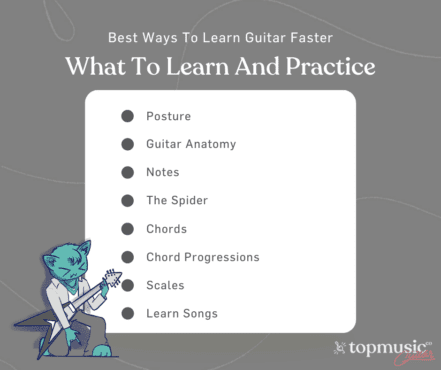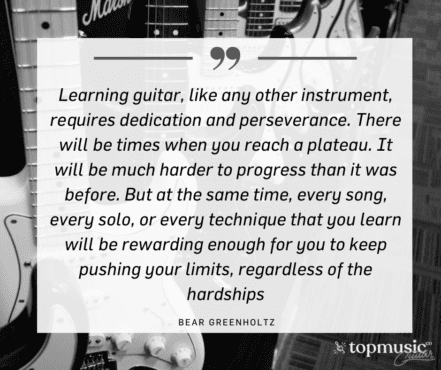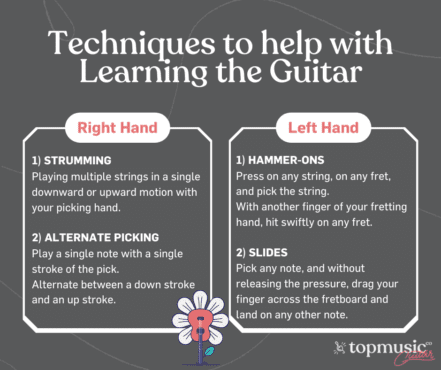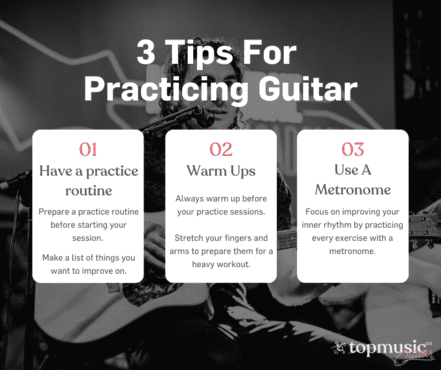Are you looking for the best ways to learn guitar fast? Check out these top tips from Bear Greenholtz!
From the appearance of the Spanish vihuela around the 15th century to modern guitars- this versatile instrument, known as guitar in general, has had an ever-growing appeal and importance to musicians regardless of their genre and era.
But what’s the best way to learn the guitar?
Table Of Contents:
First, acquire a guitar that is comfortable for you to hold and play. While buying your guitar, try to take someone who is familiar with this instrument with you.
The next step is to prepare yourself mentally. Learning guitar, like any other instrument, requires dedication and perseverance. There will be times when you reach a plateau. It will be much harder to progress than it was before. But at the same time, every song, every solo, or every technique that you learn will be rewarding enough for you to keep pushing your limits, regardless of the hardships that come along.
“What and how should I really learn and practice then?” you might ask. And my answer to your questions is as follows.
The very first thing you need to learn is how to hold the instrument. If the posture goes unchecked, you will pick up unwanted habits that slow down your progress and might even pose insidious health issues. Optimal posture generally requires having a straight back, a relaxed shoulder, a slight bend in the wrist, and an appropriate arm position.
Next, you will learn the names of the parts of a guitar. Although many kinds of guitars exist, they have most of the parts common among them.
After that, learn the names of the notes on the fretboard. When you push your finger on a string on a specific fret and let the string vibrate, what you hear is a note. There is a set of 12 notes that are distributed on the fretboard of a guitar in a specific arrangement and multiple times. These notes are the building blocks of western music.

First, you need to increase the strength and dexterity of your fingers and let them develop muscle memory. There are a lot of exercises for beginners to accomplish this goal. The most common exercise is The Spider. Here is the rudimentary version of this:
“With the correct and relaxed posture, move your left hand and hover it over the fretboard (for a right-handed guitar, it will be your right hand).
Using your index finger, press the 1st fret of the 6th string (the thickest string) with enough pressure so that a clean sound is produced when you pick the string using your other hand.
For picking, use a plectrum, as it is easier to notice whether the note is clear enough. Now, using your middle finger, press the 2nd fret and play with a clear sound without moving your 1st finger. Then the 3rd and 4th fingers will follow, respectively pressing the 3rd and 4th fret. After this, proceed to the strings below in succession.”
Keep in mind: Throughout the exercise, try to keep all your fingers as close to each other as possible. Do not lift any finger until all the fingers are on the fretboard. This exercise is also good for learning alternate picking.
Now it’s time to learn some chords. Chords are a bunch of notes with specific relations among them that are played together. First, you will learn the open chords.
After learning these chords, you will be able to play several songs already. These chords are A major, A minor, C major, D major, D minor, E major, E minor, and G major. Don’t worry about the words major and minor, you will learn about them in detail soon. As your fingers lack strength and dexterity, your finger might hurt and feel awkward at first. But you will get through it fairly quickly.
After mastering the basic chords, you will proceed to learn basic chord progressions.
A chord progression is playing two or more chords in succession. For example, from A major to D minor to E major is a possible and common chord progression. Moving from one chord to another is difficult for beginners as their fingers lack dexterity. To ease up the chord changes, there is one thing you can do while practicing individual chords:
“Keep your fretting hand relaxed but as close to the fret as possible. Now try to make the shape of a specific chord as accurately as you can and plant your fingers on the fretboard to hold the chord. Check for any buzz or muted strings and correct them. Release your fingers and repeat the whole process a few times. This will train your finger to memorize the chord shape and play accurately.”
Scales are a set of notes with specific relations among them. There are hundreds of scales. Don’t get overwhelmed, and focus on learning two scales first: the Major scale and the Chromatic scale. Learn how to construct and play these on a single string before moving on to the six-string version. When you are comfortable with the major scale on one string as well as on all six strings, learn a few really basic major and minor arpeggios. This will help you understand how chords are related to scales.
Always try to learn songs that match your skill level. This is of the utmost importance. Learning songs will motivate you to practice and learn new techniques. It functions as a tangible goal for you to achieve and shows how the chords and scales are used by a real musician.

Prepare a practice routine before starting your session. Make a list of things you want to improve on a particular practice session. Your list can include warm-up exercises, left and right-hand focused exercises, a section of your favorite song, etc.
Always warm up before your practice sessions. Stretch your fingers and arms to prepare them for a heavy workout. Pick up any warm-up exercises you want, but don’t skip them altogether.
This is crucial. You don’t need to learn time signatures or other stuff right off the bat. They are interesting, I know, but you don’t need them now. Focus on improving your inner rhythm first by practicing every exercise with a metronome. Set the metronome at a comfortable tempo and play along, following the ticks of each beat. Don’t rush, don’t lag, and strictly follow the metronome.
Strumming means playing multiple strings in a single downward or upward motion with your picking hand. First, try to alternate between the down strum and up strum while holding any chord or even muting all the strings with your fretting hand. Then you can move on to other strumming patterns. Don’t forget to use the metronome.
Play a single note with a single stroke of the pick. Strictly alternate between a down stroke and an up stroke. You can play any scale pattern or spider pattern with your fretting hand for this.

Press on any string, on any fret, and pick the string. Now, with another finger of your fretting hand, hit swiftly on any fret above the note you played. A new note will be heard. This is called a hammer-on.
Pick a note as before, but now, without releasing the pressure, drag your finger across the fretboard and land on any other note. You have connected two different notes with a slide.
This technique is quite challenging, even for intermediate players. Again, play a note, but this time pull the string down a bit without decreasing the pressure, and release or pull the string off. You will hear the open string ringing. This is pull-off to the open string. Next, you should practice pulling-off to a fretted note behind the note you just played. Practice this with every pair of fretting hand fingers.
The most valuable advice that I can give you is “play slow.” Notice and mark every small imbalance in your technique. If having a private tutor is a viable option for you, take it.
You might not understand why one chord works well with another chord or scale. You will find your answers eventually. For now, just keep improving your motor skills.
Learn to listen. Be it your favorite song or your “boring” exercises, listen carefully. And learn to tune your guitar by ear, don’t rely on apps.
Take enough rest between your practice sessions. Overdoing will not serve you any benefits.

After mastering the aforementioned techniques, you can call yourself “a beginning guitarist.” But you have just barely scratched the surface of playing guitar.
The next big challenge you should take up is basic music theory. Music theory will answer many of the questions you have had all this time. You will learn why and how the things you have played so far work. It will give a framework for analyzing the music of others and creating your own. During this time, learn as many techniques as possible and actually use them in your playing.
On a final note, try to learn anything that you want to play without compromising the clarity and accuracy of your playing. This journey is harsh but nonetheless exhilarating. Listen carefully to everything you play, and play accurately everything you hear.
P.S. Looking for help with teaching your guitar students? Check out TopMusicGuitar– an absolute goldmine of guitar teaching resources!
